SEC S16-W4 STEEM Ecosystem Resilience
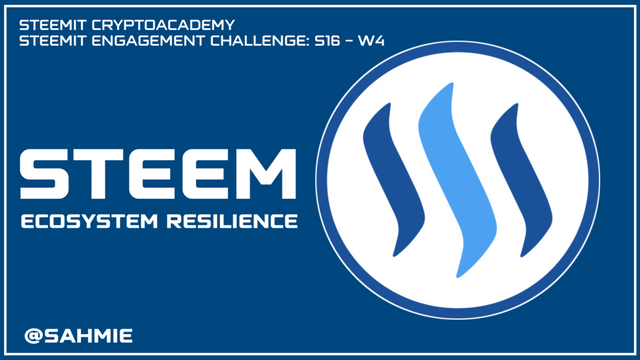 |
|---|
INTRODUCTION |
Resilience is all about having the strength and determination to face challenges, setbacks, and changes without giving up. It is like being a tough cookie that can bounce back from any tough situations.
Just like a rubber band that stretches but doesn't break, that is how resilience helps us keep going even when things get tough. Therefore, it is all about being flexible, adaptable, and having the courage to keep going no matter what.
 |
|---|
Therefore, under this week's topic, we will looking at what makes STEEM Ecosystem a wonderful Blockchain that keeps overcoming the test of time. So, like always, I hope you get to learn something new from the lesson.
How has the STEEM ecosystem demonstrated its resilience to market fluctuations and changing trends over time? |
|---|
Knowing what resilience is all about, I can say that the STEEM ecosystem has shown resilience by adapting to market fluctuations and changing trends. It has been our own superhero that has been withstanding any challenge thrown its way.
When the market goes up and down, STEEM finds a way to keep going strong. Like a flexible tree that bends with the wind but doesn't break, STEEM Keep s going strong over 7 years now. The STEEM community is always evolving, creating new projects and engaging activities to keep things exciting. So even when things change, STEEM is ready to roll with the punches and keep on thriving.
However, here is how the STEEM ecosystem has shown its incredible resilience to market fluctuations and changing trends over time.
Diverse Community:
The STEEM ecosystem is engineered by a diverse and passionate community. This diverse group of individuals brings unique perspectives and ideas to the table, allowing the ecosystem to adapt and thrive in different market conditions.
Continuous Development:
The STEEM ecosystem is constantly evolving and improving. Developers and contributors work tirelessly to introduce new features, enhance user experience, and address any challenges that arise. This adaptability ensures that the ecosystem stays relevant and resilient.
Decentralized Governance:
STEEM's decentralized governance model allows the community to have a say in the platform's direction. This means that decisions are not solely dictated by a central authority, but rather through a consensus mechanism. This democratic approach enables the ecosystem to respond and adapt to changing trends and market conditions.
Innovative Projects:
The STEEM ecosystem is a hub of innovation. From decentralized applications (DApps) to various initiatives, the community is always coming up with new and exciting projects, example includes the engagement challenge on Steemit, the most popular DApp on the STEEM Ecosystem. This diversity of projects ensures that the ecosystem remains dynamic and resilient, even in the face of market fluctuations.
Strong Community Support:
The STEEM community is known for its strong support and camaraderie as members actively engage with each other, provide feedback, and support one another's endeavors by upvoting and hosting contests. This support network acts as a safety net during market fluctuations, helping individuals navigate challenges and find opportunities.
How can the analysis of on-chain metrics, such as daily transactions, community participation and token distribution, provide insights into the health and robustness of the STEEM ecosystem? |
|---|
ON-CHAIN METRICS basically means looking at the numbers and data that tell us what's happening on a blockchain. This is like taking a peek behind the scenes to see how things are going.
These metrics include things like the number of transactions happening, the amount of cryptocurrency being moved around, and even the activity of different users. Because by analyzing these metrics, we get a better understanding of how a blockchain is performing and how people are using it.
This I can say is like having a magnifying glass to see the little details and patterns.
Therefore when we look at on-chain metrics like daily transactions, community participation, and token distribution of STEEM is like checking the pulse of the STEEM ecosystem as these metrics give us a glimpse into how healthy and strong the STEEM ecosystem is.
For example, daily transactions show us how active people are on the platform. Therefore, if there is a lot of transactions happening, it means people are engaged and using STEEM and community participation on the other hand tells us how involved and enthusiastic people are about the platform because the more people participating, the more vibrant and lively the community is just as we do with the engagement challenge.
Token distribution is also another important metric to look at as this shows us how the STEEM tokens are spread out among users. Therefore, when there is a fair distribution, it means more people have a stake in the ecosystem, in turn this helps to ensure a balanced and decentralized community.
Also, one important metric is the active user count, which tells you how many people are actively using the platform. This gives you an idea of the platform's popularity and engagement.
Another metric to consider is the transaction volume, which measures the amount of cryptocurrency being moved around on the blockchain. A higher transaction volume can indicate increased usage and activity within the ecosystem.
Additionally, you might want to look at metrics related to developer activity, such as the number of code commits or updates to the blockchain's software. This provides us insights into the ongoing development and maintenance of the platform.
Therefore, by analyzing all these metrics about the STEEM token, we can get insights into whether the STEEM ecosystem is thriving, growing, and sustainable.
Wondering where to find such metrics? Don not worry too much as we can find these on-chain metrics of the STEEM blockchain on websites and platforms such as SteemWorld and SteemScan.
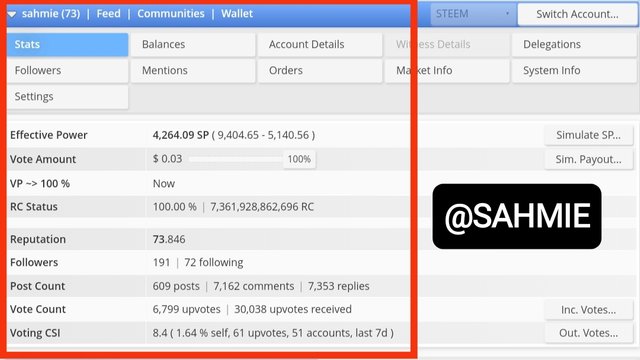 |
|---|
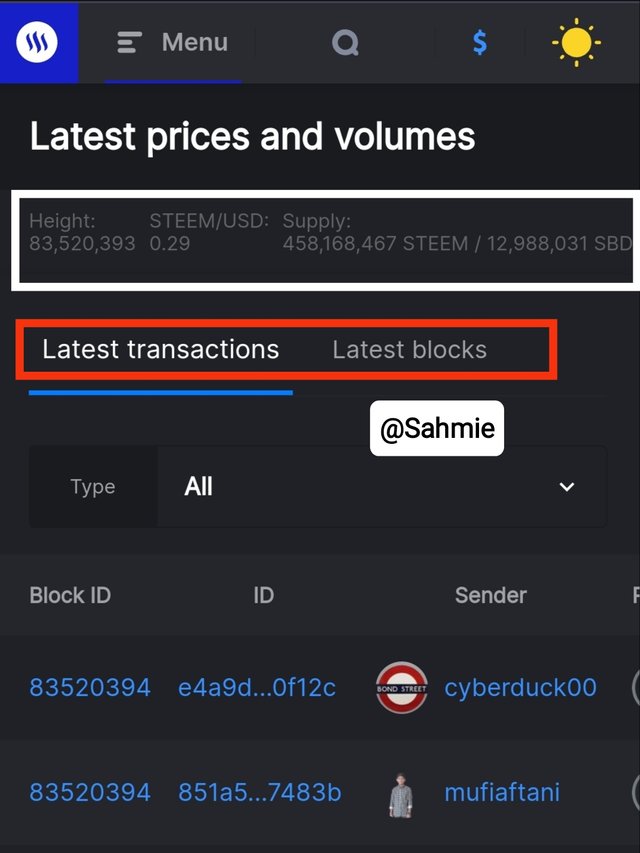 |
|---|
These platforms provide detailed information about transactions, user activity, and other metrics that can help you understand what is happening on the STEEM blockchain.
How can STEEM's Relative Strength Analysis versus other cryptocurrencies help investors identify potential opportunities in varying market conditions? (Provide an example that shows your analysis) |
|---|
The word "Relative" simply means that we are comparing one thing to another. It is like looking at how one thing is doing compared to another thing. For example, if you want to know how fast you are running, you might compare your speed to your friend's speed. You'll see if you're faster or slower than them, right?
Whereas, "Strength" means how powerful or strong something is. This could be physical strength, like how much weight someone can lift at the gym. However, in the context of our topic this week, we are talking about the strength of the STEEM ecosystem.
So, when we say "Relative Strength Analysis," we're comparing the strength of the STEEM ecosystem to other cryptocurrencies or market benchmarks like Bitcoin, Ethereum or Solana. It helps us understand how well STEEM is doing compared to others. It's like asking, "Is STEEM stronger or weaker compared to other cryptocurrencies?"
Therefore, Relative Strength Analysis is a tool that helps us understand how strong or weak something is compared to others. It is a way to measure the power and performance of one thing relative to another.
In the world of finance, Relative Strength Analysis is used to compare the performance of different investments, like stocks or cryptocurrencies. It looks at how well one investment is doing compared to others. It can give you insights into which investments might be stronger or weaker in terms of price movements. I couldn't help but ask, does this not sound familiar to something we've done before? Then I remembered it is basically the same as our Cross-Asset Correlation Analysis.
Hence, Relative Strength Analysis can be a helpful tool for investors to spot potential opportunities in different market conditions when comparing STEEM to other cryptocurrencies.
Let's say we have three cryptocurrencies:
- STEEM
- Bitcoin, and
- Ethereum.
To analyze their relative strength, we would look at their performance over a specific period, let's say the past month.
If we find that STEEM has consistently outperformed both Bitcoin and Ethereum during that period, it suggests that STEEM has been relatively stronger compared to the other two. This could indicate that STEEM has been attracting more buyers or experiencing positive market sentiment.
On the other hand, if STEEM has consistently underperformed Bitcoin and Ethereum, it might indicate that STEEM has been relatively weaker. This could mean that investors are less interested in STEEM compared to the other two cryptocurrencies.
By analyzing the relative strength of STEEM against other cryptocurrencies, investors can identify potential opportunities.
For example, if STEEM has been consistently strong, it might be an indication that it has positive momentum and could be a good investment choice. Conversely, if STEEM has been consistently weak, it might suggest caution or the need to explore other investment options.
Carrying out relative strength analysis as we've learnt involves comparing the performance of STEEM to other assets in order to determine its relative strength and to do that, we have to;
Select a time period:
Choose a specific timeframe to analyze, such as a week, a month, or a year. This will help provide a clear comparison.
Choose comparable assets:
Identify other cryptocurrencies or investments that are similar to STEEM and are relevant to your analysis. For example, you might compare STEEM to Bitcoin, Ethereum, or other altcoins.
Gather price data:
Collect historical price data for both STEEM and the other assets you selected over the chosen time period. You can find this data on various financial websites or trading platforms.
Calculate relative strength:
Calculate the relative strength of STEEM by comparing its price performance to the other assets. One common method is to calculate the ratio of STEEM's price change to the price change of the other asset. This will give you a relative strength value.
Analyze the results:
Interpret the relative strength values you calculated. If STEEM consistently shows higher values compared to other assets, it suggests relative strength. Conversely, lower values indicate relative weakness.
For Example,
Let us hypothetical analyze the relative strength of STEEM compared to Bitcoin (BTC).
First, we need to gather historical price data for both STEEM and BTC. We can use platforms like CoinMarketCap or CoinGecko to find this data.
Next, we calculate the percentage change in price for both assets over a specific period, let's say the past month. We can do that by using;
I.e, if STEEM's price at the beginning of the month was $0.50 and it's currently $0.70, the percentage change would be:
((0.70 - 0.50) / 0.50) * 100 = 40%
For Bitcoin, if the price at the beginning of the month was $50,000 and it's currently $60,000, the percentage change would be:
((60,000 - 50,000) / 50,000) * 100 = 20%
Now, we can compare the percentage changes. Therefore, in this example, STEEM has outperformed Bitcoin over the past month, as it has a higher percentage change (40% for STEEM vs. 20% for BTC).
By repeating this process over different time periods and comparing the relative strength of STEEM to other assets or benchmarks, we gain insights into its performance and potential trends.
Okay, let's put our hypothetical example into practice using actual values of both Assets.
| Date | STEEM price ($) | BTC price ($) |
|---|---|---|
| Oct. 2 | 0.182908 | 27,967.51 |
| Nov. 2 | 0.221613 | 34,625.69 |
| Dec. 15 | 0.258515 | 43,088.72 |
All figures where gotten from the images below.
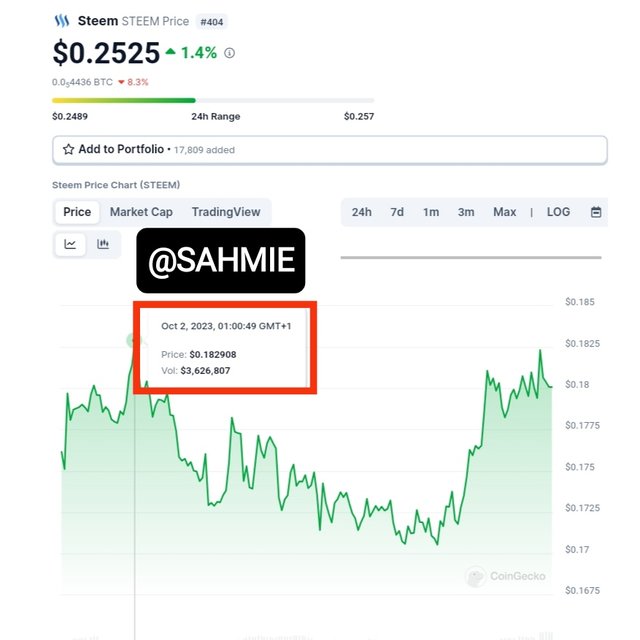 | 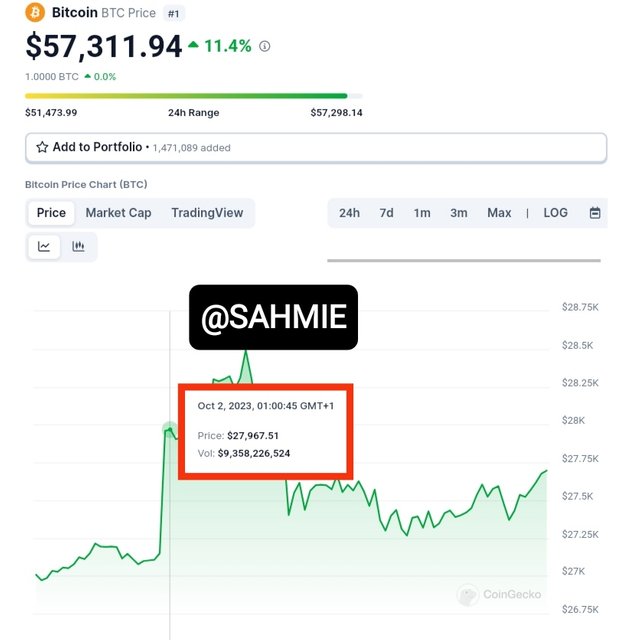 |
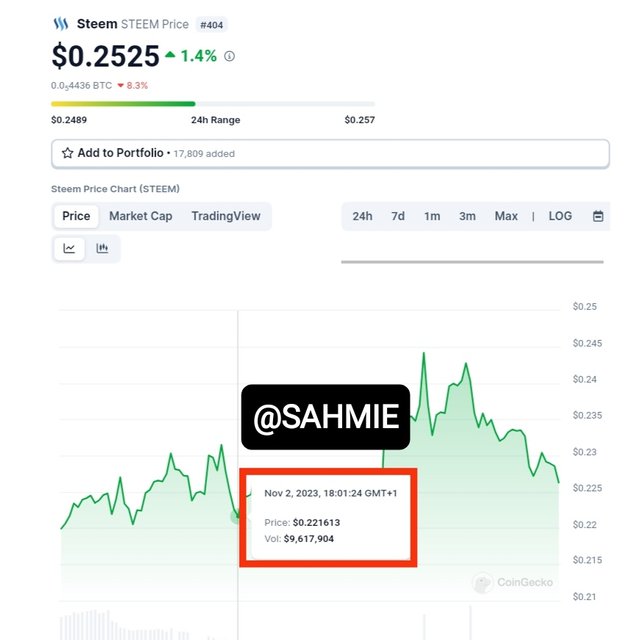 | 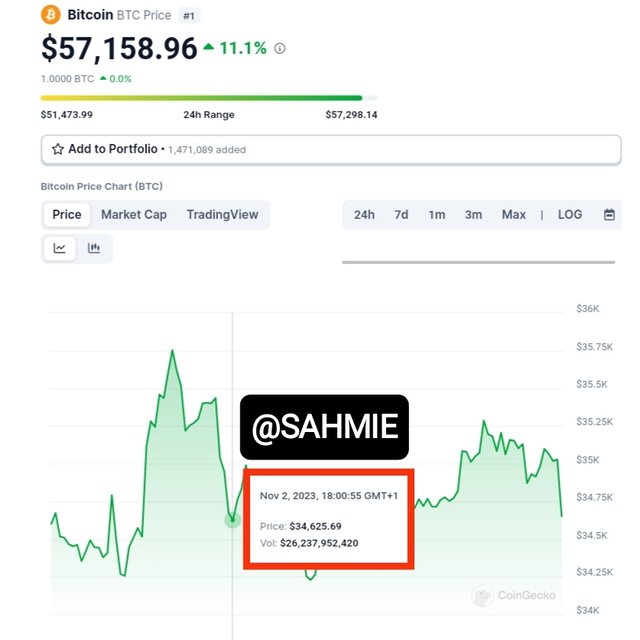 |
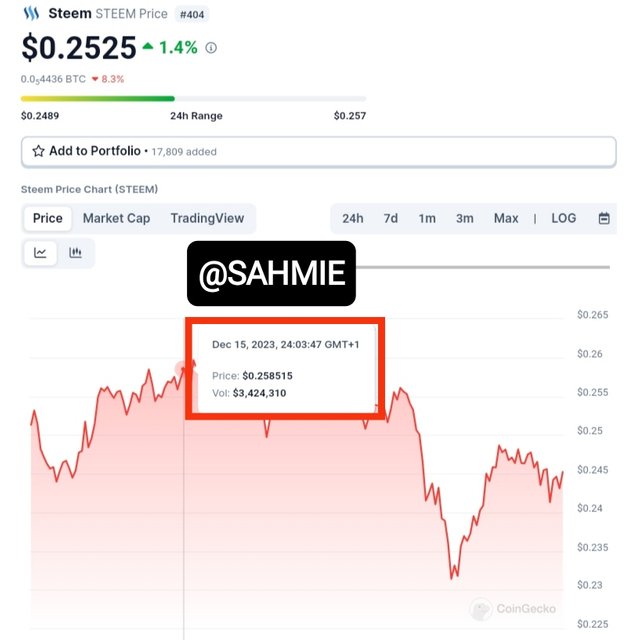 | 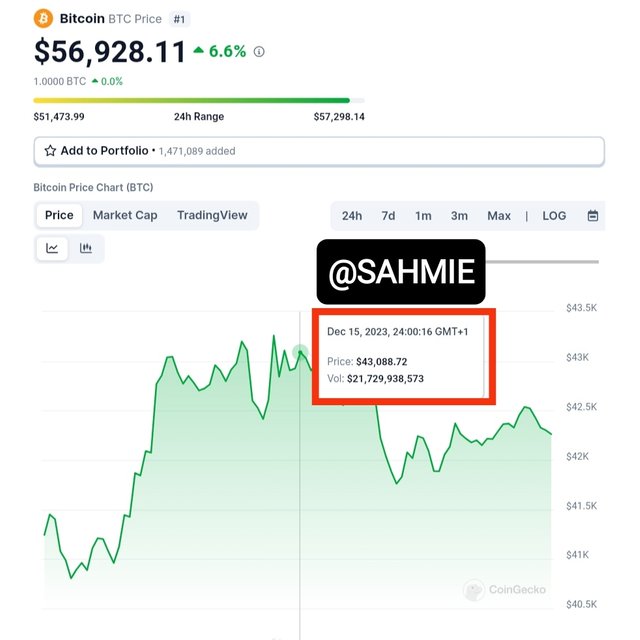 |
Now, let us calculate their change in percentage using the formula;
∆ STEEM From Oct. 2 To Nov. 2
∆ STEEM % =[(0.221613 - 0.182908)/0.182908] x 100
∆ STEEM % = (0.038705 / 0.182908) x 100
∆ STEEM % = 0.211609115 x 100 = ~ 21.16%
∆ BTC From Oct. 2 To Nov. 2
∆ BTC % =[(34,625.69 - 27,967.51)/27,967.51] x 100
∆ BTC % = (6,658.18 / 27,967.51) x 100
∆ STEEM % = 0.238068387 x 100 = ~ 23.81%
∆ STEEM From Nov. 2 To Dec. 15
∆ STEEM % =[(0.258515 - 0.221613)/0.221613] x 100
∆ STEEM % = (0.036902 / 0.221613) x 100
∆ STEEM % = 0.166515502 x 100 = ~ 16.65%
∆ BTC From Nov. 2 To Dec. 15
∆ BTC % =[(43,088.72 - 34,625.69)/34,625.69] x 100
∆ BTC % = (8,463.03 / 34,625.69) x 100
∆ BTC % = 0.244414768 x 100 = ~ 24.44%
Now, comparing the percentage changes in these examples, we can see that BTC outperformed STEEM over the two occasions since it had higher percentage changes of (23.81% and 24.44%) over STEEM's (21.16% and 16.65%) respectively.
What are the possible implications of fundamental events, such as STEEM protocol upgrades, on relative strength dynamics and market participants' perception of the ecosystem? |
|---|
When it comes to fundamental events like STEEM protocol upgrades, they can have both positive and negative implications on the relative strength dynamics and how market participants perceive the ecosystem, and this include:
Enhanced functionality:
Protocol upgrades can introduce new features, improvements, or fixes to the STEEM blockchain. This can attract more users and developers, leading to increased adoption and positive market sentiment.
Increased scalability:
Upgrades that improve the scalability of the STEEM blockchain can handle more transactions efficiently. This can make the ecosystem more robust, attract new projects, and potentially increase the value of STEEM.
Improved security:
Upgrades focused on enhancing the security of the protocol can instill confidence in market participants. This can lead to increased trust, attracting more investors and potentially positively impacting the relative strength of STEEM.
Technical issues:
Protocol upgrades may encounter technical challenges or bugs that could disrupt the normal functioning of the blockchain. This can lead to negative market sentiment and a potential decline in the relative strength of STEEM.
Resistance to change:
Some market participants might be resistant to protocol upgrades, especially if they disrupt existing systems or require significant adjustments. This resistance can create uncertainty and negatively impact the perception of the ecosystem.
Market reaction:
The market's response to protocol upgrades can be unpredictable. Even with positive upgrades, market participants might react differently, causing fluctuations in the relative strength dynamics of STEEM.
How does the integration of on-chain analysis with relative strength assessment provide a comprehensive perspective for investors seeking to understand the overall strength of the STEEM ecosystem and make informed decisions? (Provide an example that shows your analysis) |
|---|
Integrating on-chain analysis with relative strength assessment can give investors a clear understanding of the strength of the STEEM ecosystem.
Since On-chain analysis involves looking at the data and activities happening directly on the STEEM blockchain, it helps us understand things like the number of transactions, the amount of STEEM being staked, and the overall activity level of users. This data gives us insights into the health and vitality of the ecosystem.
Relative Strength Analysis, on the other hand, is about comparing the performance of STEEM against other cryptocurrencies or market benchmarks. which helps us understand how STEEM is performing relative to its peers.
By combining these two approaches, investors can get a clearer picture of the overall strength of the STEEM ecosystem.
For example, let's say we notice a significant increase in the number of transactions happening on the STEEM blockchain through on-chain analysis. This suggests a growing level of activity and engagement within the ecosystem.
If, at the same time, we see that STEEM is outperforming other similar cryptocurrencies in terms of price or market capitalization through relative strength analysis, it indicates that investors have a positive perception of STEEM compared to its competitors. This comprehensive perspective allows us to make more informed decisions.
They can assess the underlying fundamentals of the STEEM ecosystem through on-chain analysis while considering how it is performing relative to other cryptocurrencies through relative strength assessment. This information helps us gauge the overall strength of STEEM and make decisions based on a more complete understanding of the ecosystem.
CONCLUSION |
In conclusion, integrating on-chain analysis with relative strength assessment gives investors a complete understanding of the overall strength of the STEEM ecosystem. By looking at the data on the STEEM blockchain and comparing it to other cryptocurrencies, investors can make informed decisions about STEEM. It helps them see how STEEM is performing compared to others and assess the health of the ecosystem. This comprehensive perspective enables investors to make more confident choices.
I wish to invite @starrchris, @ngoenyi, @chants and @hamzayousafzai.
Thank You for your Time
NOTE: Always have a smile on your face, as you are never fully dressed without one.

Thank you, friend!


I'm @steem.history, who is steem witness.
Thank you for witnessvoting for me.
please click it!
(Go to https://steemit.com/~witnesses and type fbslo at the bottom of the page)
The weight is reduced because of the lack of Voting Power. If you vote for me as a witness, you can get my little vote.
Upvoted! Thank you for supporting witness @jswit.
Upvoted. Thank You for sending some of your rewards to @null. It will make Steem stronger.
Your breakdown of on-chain metrics and relative strength analysis provides a comprehensive understanding of STEEM's health and performance. Best of luck in the contest
Hey, Sahmie. What's up, dude. I'm so delighted to see you in this contest, and your submission is fantastic. Your description of how combining on-chain analysis with relative strength evaluation might give investors with a more comprehensive picture is smart. Anyway, best wishes for success, dude.
Amigo @sahmie de nuevo has traido una excelente publicación nutrida de conocimientos acerca del tema. Es genial el aporte en sabiduría que estás dando en cada semana.
La resiliencia de Steem sobre todo en los momentos más difíciles nos han enseñado a apreciar cada día el esfuerzo del equipo para mantener activa esta red social. La participación de cada usuario en las dinámicas con la creación de contenidos de calidad y la interacción, así como una distribución de las recompensas equilibradas y justas, son fundamentales pues esta red social se mueve en función del poder que cada uno aporta con su creatividad e interacción.
Saludos y éxitos.
Resistance specifies STEEM's capability to withstand market changes and also progressing fads. Like a durable tree it flexes however does not damage, adjusting to obstacles over its 7-year journey. The area's variety cultivates advancement along with assistance crucial for strength. On-chain metrics consisting of day-to-day purchases plus token circulation give understandings right into the community's wellness. These metrics, comparable to a magnifying glass disclose individual involvement plus decentralization, leading capitalists in the direction of notified choices for STEEM's stamina coupled with durability.
By having a diverse community and with the strong engagement and interaction of uses with each other as well as with the strong governance system at steem blockchain Steem ecosystem is showing its resilience as well as it has been also source of attraction and attention for investors in the upcoming future so I see future of this blockchain very bright and not only I am home full about it friendly but there are some technical and fundamental analysis that are showing it as you have also explain many things by explaining your fundamemtal analysis.